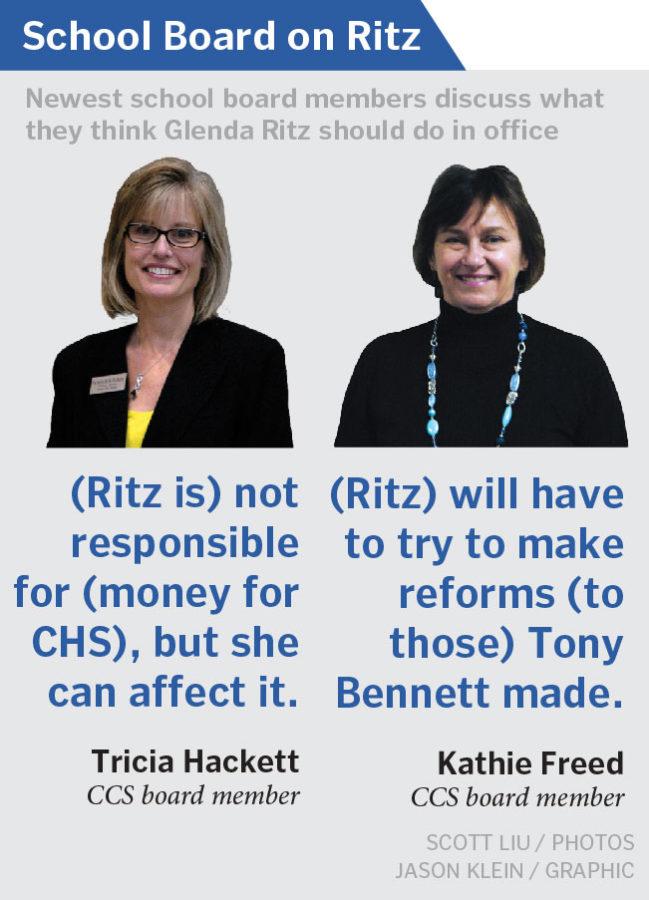Glenda Ritz will be inaugurated as Indiana’s Superintendent for Public Instruction on Jan. 14 in an election victory that CCS board member Tricia Hackett said “was a shock” to the state. Hackett said Ritz connected with the grassroots audience better than incumbent Tony Bennett, and that Bennett focused on low-performing schools. Doing so, she said, left out many students from high-performing school districts, such as Carmel Clay Schools.
 As for the future, Hackett said she hopes the legislation is carried through so Carmel Clay Schools is labeled a performance-qualified school district. She said Carmel has met every state-set benchmark, including SAT and ACT scores and graduation rate.
As for the future, Hackett said she hopes the legislation is carried through so Carmel Clay Schools is labeled a performance-qualified school district. She said Carmel has met every state-set benchmark, including SAT and ACT scores and graduation rate.
She said, “We (at Carmel Clay Schools) would utilize this title to loosen the mandates tied to funding so (we) can achieve more.”
It seems Ritz has heard this call, and she indicated there may be some changes on the horizon for schools like Carmel. Ritz, who has been involved in education for 34 years, said via email, “All Indiana schools should strive to be high performing schools…I do believe there should be both flexibility and freedom from regulations if a school is deemed as having a ‘high performing’ school culture.”
Kathie Freed, newly elected CCS board member and former math teacher at CHS, said she too hopes the state will recognize Carmel Clay Schools as a performance-qualified school district.
 When schools began to adapt to RISE and school districts began receiving grades, Freed said, “High success schools (had to) jump through the same hoops as lower-performing schools.”
When schools began to adapt to RISE and school districts began receiving grades, Freed said, “High success schools (had to) jump through the same hoops as lower-performing schools.”
She said Ritz was favored in the election because she is expected to try what Freed called “softening of the edges” of the new regulations for school districts.
Hackett said she hopes the model for grading school districts “A to F” becomes clearer. She said people are confused and no one really knows how to obtain the grades; for example, Carmel Clay Schools recently earned an “A” but is unsure why.
For her part, Ritz said, “It is my plan to work towards a growth model student assessment system that will then lead to a revised school accountability system. I am not in favor of the current ‘A-F’ model.”
According to Hackett, while Carmel Clay Schools has met all necessary benchmarks, it has done so while receiving the third-lowest state funding.
Hackett said via email, “I look forward to the day we can all join hands and fight the real battle, the battle of adequate funding for the education of our youth.”
Additionally, she said, “Carmel Clay Schools can’t keep (smaller) class size and pay bills until (it gets) more cash.” In the past two years, Hackett said the funding per pupil has decreased over $700 and that the funding situation makes it difficult to award exemplary teachers the compensation they deserve.
Ritz said, “I want all schools to have funding they need to provide opportunities for their students.”
She said the current state funding arrangement is partly based on Free and Reduced Lunch Programs, which is why Carmel Clay Schools has a lower funding rate. According to high-schools.com, 4 percent of students at CHS use the free and reduced lunch program as opposed to the Indiana average of 28 percent.




























![Keep the New Gloves: Fighter Safety Is Non-Negotiable [opinion]](https://hilite.org/wp-content/uploads/2024/12/ufcglovescolumncover-1200x471.png)
















































![Review: “We Live in Time” leaves you wanting more [MUSE]](https://hilite.org/wp-content/uploads/2024/12/IMG_6358.jpg)
![Review: The premise of "Culinary Class Wars" is refreshingly unique and deserving of more attention [MUSE]](https://hilite.org/wp-content/uploads/2024/12/MUSE-class-wars-cover-2.png)
![Introducing: "The Muses Who Stole Christmas," a collection of reviews for you to follow through winter [MUSE]](https://hilite.org/wp-content/uploads/2024/12/winter-muse-4.gif)
![Review: "Meet Me Next Christmas" is a cheesy and predictable watch, but it was worth every minute [MUSE]](https://hilite.org/wp-content/uploads/2024/11/AAAAQVfRG2gwEuLhXTGm3856HuX2MTNs31Ok7fGgIVCoZbyeugVs1F4DZs-DgP0XadTDrnXHlbQo4DerjRXand9H1JKPM06cENmLl2RsINud2DMqIHzpXFS2n4zOkL3dr5m5i0nIVb3Cu3ataT_W2zGeDAJNd_E-1200x884.jpg)
![Review: "Gilmore Girls", the perfect fall show [MUSE]](https://hilite.org/wp-content/uploads/2024/11/gilmore-girls.png)
![Review in Print: Maripaz Villar brings a delightfully unique style to the world of WEBTOON [MUSE]](https://hilite.org/wp-content/uploads/2023/12/maripazcover-1200x960.jpg)
![Review: “The Sword of Kaigen” is a masterpiece [MUSE]](https://hilite.org/wp-content/uploads/2023/11/Screenshot-2023-11-26-201051.png)
![Review: Gateron Oil Kings, great linear switches, okay price [MUSE]](https://hilite.org/wp-content/uploads/2023/11/Screenshot-2023-11-26-200553.png)
![Review: “A Haunting in Venice” is a significant improvement from other Agatha Christie adaptations [MUSE]](https://hilite.org/wp-content/uploads/2023/11/e7ee2938a6d422669771bce6d8088521.jpg)
![Review: A Thanksgiving story from elementary school, still just as interesting [MUSE]](https://hilite.org/wp-content/uploads/2023/11/Screenshot-2023-11-26-195514-987x1200.png)
![Review: "When I Fly Towards You", cute, uplifting youth drama [MUSE]](https://hilite.org/wp-content/uploads/2023/09/When-I-Fly-Towards-You-Chinese-drama.png)
![Postcards from Muse: Hawaii Travel Diary [MUSE]](https://hilite.org/wp-content/uploads/2023/09/My-project-1-1200x1200.jpg)
![Review: "Ladybug & Cat Noir: The Movie," departure from original show [MUSE]](https://hilite.org/wp-content/uploads/2023/09/Ladybug__Cat_Noir_-_The_Movie_poster.jpg)
![Review in Print: "Hidden Love" is the cute, uplifting drama everyone needs [MUSE]](https://hilite.org/wp-content/uploads/2023/09/hiddenlovecover-e1693597208225-1030x1200.png)
![Review in Print: "Heartstopper" is the heartwarming queer romance we all need [MUSE]](https://hilite.org/wp-content/uploads/2023/08/museheartstoppercover-1200x654.png)




